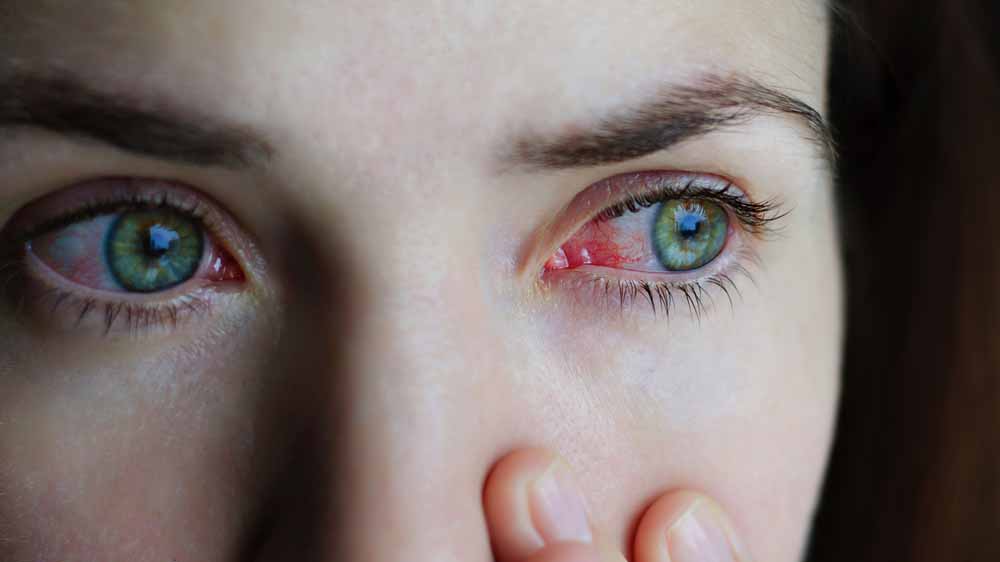The word conjunctivitis refers to an inflammation of the transparent membrane that covers the peripheral parts of the eye and the inner surface of the eyelids (the conjunctiva). This inflammation may be infectious or non-infectious in origin.
Organisms that infect the conjunctiva include bacteria, viruses, or fungi. These organisms may infect the eye through direct contact for e.g. when a contaminated hand rubs the eye; or may extend into the eye once they are already present in the body for e.g. if a herpes infection involves the nerves of the face and thus extends into the eye due to its close proximity.
Non-infectious reasons for conjunctivitis mainly have allergic reactions as their driving force.


Conjunctivitis Symptoms:
- Red eye
- Discharge from the eye:
- This may be thick or watery in consistency, and green or yellow in color
- It may cause the eyelids to stick together on waking up
- Gritty feeling in the eye
- Stinging or burning sensation in the eye
- Light sensitivity
- Itchiness
- Swelling of the eyelids
- Outgrowth of a membrane over the eye
- Fever
- Feeling unwell
Tests:
The diagnosis of conjunctivitis is mainly made clinically by the ophthalmologist. However, laboratory analysis of substances taken from your eye may be done. Your doctor may also evaluate the condition of your eye using different medical apparatus.
Therapy:
Depending on the severity and etiology of the disease, your doctor may prescribe:
- Antibiotic eye ointment
- Antibiotic eye drops
- Oral Antibiotics
- Antiviral eye ointment
- Antiviral eye drops
- Oral Antiviral medication
- Eye ointment/drops to reduce inflammation
- Eye drops containing artificial tears
- Anti-allergic eye drops or ointment
- Cold compresses
Complications:
Conjunctivitis is generally a benign disease and usually resolves by itself. However, in some cases – especially if the Herpes Simplex Virus is involved – the infection may progress to involve the entire eye or extend forwards to cause corneal scarring. In order to prevent these serious complications, it is important to go to the doctor for an eye check up as soon as symptoms are noted.
Preventative measures:
Infective Conjunctivitis is mainly transmitted through direct contact. This means that if a person with infective conjunctivitis touches their eye and then shakes hands with a non-infected person, they transfer the germs to the latter. This will now cause the non-infected person to also develop conjunctivitis if they touch their eye with the contaminated hand. Hence, the main safeguard against infective conjunctivitis involves decreasing the contact between contaminated objects and the eye. These objects may be the patient’s hands or other unhygienic material he/she may rub his/her eyes with. This is why it is wise to refrain from rubbing one’s eyes with unsanitized hands, and to ensure that any material that is coming in contact with your eye is clean. It is also good practice to use a sanitiser immediately after shaking hands with someone or touching a fomite (objects that may carry germs for e.g. door knobs, etc) as this decreases disease transmission.
Contact lenses act as one of the biggest carriers of infection if the user is unable to disinfect them properly before use. Proper technique should hence be employed when one is putting their contact lenses into the eye or while removing them.
In the case of allergic conjunctivitis, contact with possible allergens should be reduced.
Conditions that mimic conjunctivitis:
Although conjunctivitis is mainly a benign condition, its symptoms overlap with a few very serious conditions of the eye. When you go for a check-up, your physician will first and foremost exclude these conditions to ensure that your sight is not threatened in any way. These conditions include:
- Uveitis (inflammation of the iris, choroid or ciliary body)
- Scleritis (inflammation of the scleral membrane – a tough, white, fibrous layer that surrounds the eyeball)
- Glaucoma (a condition in which the optic nerve is damaged, compromising the patient’s field of vision)
- Keratitis ( inflammation of the cornea which is the transparent membrane that covers the front of the iris and the pupil)
- Corneal ulcer (an ulcer that develops in the transparent membrane that covers the front of the iris and the pupil)
- Foreign body in the eye (a foreign body within the eye can infect the entire eyeball which may lead to very serious consequences)
References
- Ryder EC, Benson S. Conjunctivitis. [Updated 2021 Jul 18]. In: StatPearls [Internet]. Treasure Island (FL): StatPearls Publishing; 2021 Jan-. Available from: https://www.ncbi.nlm.nih.gov/books/NBK541034/
- Azari, A. A., & Arabi, A. (2020). Conjunctivitis: A Systematic Review. Journal of ophthalmic & vision research, 15(3), 372–395. https://doi.org/10.18502/jovr.v15i3.7456
Disclaimer: The information on this blog is intended to educate and inform and is not a substitute for medical advice, diagnosis or treatment. Prior to acting on the information provided on this blog, you should consult your doctor/healthcare professional.
